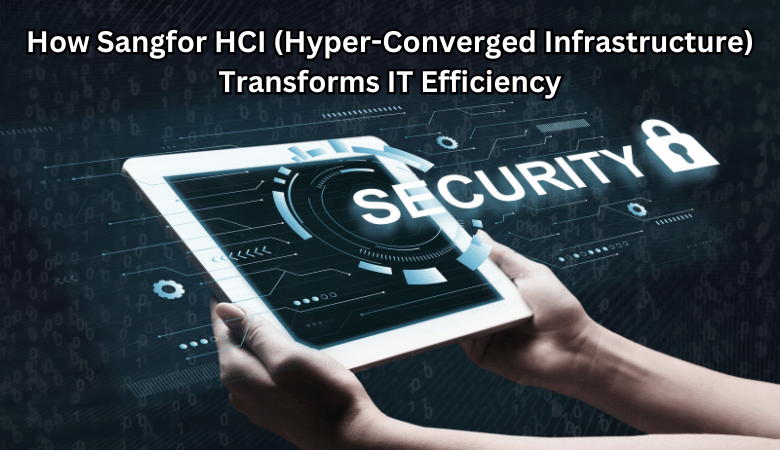How Sangfor HCI (Hyper-Converged Infrastructure) Transforms IT Efficiency

Efficient IT management is no longer a luxury—it’s a necessity for modern businesses facing rapid growth and increased demand for performance. Legacy infrastructures, with their disparate components and complex management systems, are often inefficient, costly, and difficult to scale.
This is where Sangfor Hyper-Converged Infrastructure (HCI) steps in, offering an integrated, all-in-one solution that combines computing, storage, networking, and security under one platform.
Sangfor HCI is designed to streamline IT operations, reduce costs, and enhance performance, making it the ideal choice for businesses aiming to modernize their infrastructure.
Understanding Hyper-Converged Infrastructure (HCI)
At its core, hyper-converged infrastructure (HCI) is a software-defined solution that combines computing, storage, networking, and virtualization into a single platform.
Traditionally, IT infrastructures relied on separate hardware for each of these functions, making management complex and resource-heavy. HCI removes these silos by virtualizing resources and allowing businesses to manage everything through a unified interface.
Key Elements of HCI:
- Storage Virtualization: HCI consolidates storage resources into a virtualized pool, allowing for efficient allocation and flexibility.
- Compute and Network Integration: Processing and networking are unified with storage, making deployment and scaling much simpler than traditional setups.
- Centralized Management: Instead of managing servers, storage, and networks separately, HCI provides a single dashboard for managing the entire infrastructure.
Sangfor HCI builds on these core principles, beyond basic HCI solutions, offering native security, built-in disaster recovery, and seamless scalability.
For businesses grappling with aging infrastructure and increasing demands, HCI offers a way to simplify operations while boosting efficiency.
Key Features of Sangfor HCI
Sangfor’s Hyper-Converged Infrastructure goes beyond traditional HCI solutions by offering a host of features designed to streamline IT operations and drive efficiency. Each of these features contributes to the platform’s flexibility, making it a robust solution for businesses of all sizes.
All-in-One Solution
One of Sangfor HCI’s most significant advantages is its all-in-one platform.
Instead of needing separate hardware and software for storage, computing, networking, and security, Sangfor HCI integrates all these components into a unified solution.
This reduces the complexity of IT management while cutting down on hardware costs.
- Unified Architecture: By consolidating different IT functions into a single infrastructure, Sangfor minimizes compatibility issues and maintenance overhead.
- Vendor Consolidation: Businesses no longer need to deal with multiple vendors for different hardware and software solutions, simplifying support and procurement.
Built-In Disaster Recovery
Sangfor HCI has built-in disaster recovery (DR) and continuous data protection (CDP) features, ensuring critical data is protected against failures or outages.
This native capability is essential for businesses that cannot afford downtime, offering automatic backup and near-instant recovery in case of disasters.
- Continuous Data Protection: This ensures minimal data loss by automatically backing up data at regular intervals, keeping information safe without manual intervention.
- Disaster Recovery as a Service (DRaaS): Sangfor provides a seamless DRaaS option, enabling businesses to safeguard data offsite while cutting costs on additional disaster recovery solutions.
These features eliminate the need for separate disaster recovery systems and backup software, further reducing costs and simplifying IT infrastructure. Sangfor HCI ensures that businesses have a resilient system in place without the need for complex and expensive third-party solutions.
FOR INFORMATIVE CONTENT VISIT.. : Christmas gifts
How Sangfor HCI Boosts IT Efficiency
Sangfor HCI is designed to optimize IT efficiency by reducing infrastructure complexity, automating repetitive tasks, and providing real-time insights that drive faster decision-making. Here’s how Sangfor’s platform helps businesses streamline their IT operations:
Reducing Complexity in IT Infrastructure
Traditional IT setups involve a patchwork of servers, storage systems, and networking hardware that require constant oversight and management. Sangfor HCI eliminates this complexity by consolidating everything into a single system, simplifying deployment and ongoing maintenance.
- Single Interface Management: With Sangfor HCI, IT administrators can manage compute, storage, and networking resources from a single pane of glass. This drastically cuts down the time spent juggling multiple tools or platforms.
- Fewer Points of Failure: By reducing the number of components in the infrastructure, Sangfor HCI minimizes the risk of hardware failures and decreases the burden on IT staff to maintain multiple systems.
Automation for Simplified Management
Sangfor HCI integrates AI-driven automation features that help businesses optimize their infrastructure without constant manual intervention. This reduces the time IT teams spend on routine maintenance tasks and allows them to focus on more strategic initiatives.
- AI-Driven Insights: Sangfor HCI uses artificial intelligence to provide real-time performance data and operational insights. It can predict potential issues, suggest optimizations, and automate routine maintenance tasks like backups and updates.
- Automatic Resource Allocation: Based on workload demands, Sangfor HCI dynamically allocates resources (such as CPU, memory, and storage) to where they are most needed. This ensures optimal system performance without the need for manual adjustments.
By automating these processes, Sangfor HCI significantly enhances IT team productivity and ensures that resources are always used efficiently.
Cost Efficiency and Scalability
Sangfor HCI is designed not only to simplify IT management but also to reduce operational costs and provide scalability as businesses grow. This section explores how Sangfor’s HCI solution helps businesses optimize their budget while allowing them to scale without significant capital investments.
Reducing Hardware and Maintenance Costs
One of the key benefits of Sangfor HCI is the reduction in hardware costs. By consolidating compute, storage, and networking into a single platform, Sangfor HCI eliminates the need for multiple servers, networking switches, and storage devices.
This reduces both initial capital expenditures and ongoing maintenance costs.
- Lower Total Cost of Ownership (TCO): By simplifying the infrastructure, businesses spend less on hardware, energy, and cooling requirements. Sangfor estimates that organizations can reduce their IT infrastructure costs by up to 70% when transitioning to HCI.
- Reduced Maintenance: Fewer hardware components mean fewer points of failure and less time spent on troubleshooting or maintaining individual systems. This allows IT teams to focus on higher-level strategic tasks rather than day-to-day system maintenance.
Scalability Without Overhead
Sangfor HCI’s architecture is designed with scalability in mind. Whether a business is looking to expand incrementally or scale rapidly, Sangfor HCI can accommodate these needs without the complexity or cost of traditional infrastructure expansions.
- Pay-as-You-Grow Model: Sangfor allows businesses to scale their IT resources incrementally as they grow, avoiding large upfront investments in infrastructure that may not be immediately needed.
- Effortless Expansion: Adding new nodes to Sangfor’s HCI environment is as simple as plugging in additional hardware. The system automatically integrates new nodes, distributing workloads efficiently without manual intervention from the IT team.
By reducing the need for significant upfront investments and enabling businesses to scale as needed, Sangfor HCI allows companies to align their IT spending more closely with their actual operational needs, leading to better budget management and long-term cost savings.
Real-World Applications of Sangfor HCI
Sangfor HCI’s versatility and powerful feature set make it an ideal solution for a range of industries. Its ability to integrate computing, storage, networking, and security into a single platform means that it is adaptable to businesses with diverse needs, such as healthcare, finance, education, and manufacturing. Let’s explore a few specific examples of how Sangfor HCI is being used to increase IT efficiency across industries.
Healthcare Sector
The healthcare industry is highly data-driven and requires robust IT infrastructure to handle large amounts of sensitive data, maintain security, and ensure continuous availability of services. Sangfor HCI provides an integrated solution that addresses all of these challenges.
- Data Management and Security: Healthcare organizations use Sangfor HCI to store and manage vast volumes of patient data, including medical records, imaging, and lab results, while ensuring that data is protected with Sangfor’s built-in security features.
- Uptime and Resilience: With built-in disaster recovery and continuous data protection, Sangfor HCI ensures that critical healthcare applications remain available, even in the event of an infrastructure failure or cyberattack.
Finance Sector
Financial institutions deal with vast amounts of transactional data and face strict compliance requirements. Sangfor HCI offers a secure, scalable, and reliable solution that can handle these unique demands.
- High Performance for Transactional Workloads: Sangfor HCI’s high input/output operations per second (IOPS) performance allows financial institutions to process large numbers of transactions quickly and efficiently.
- Data Protection and Compliance: Financial firms rely on Sangfor HCI’s security and disaster recovery features to ensure that data is not only protected from cyber threats but also stored in compliance with industry regulations such as GDPR and PCI-DSS.
Education Sector
With the growing trend toward digital learning and remote education, universities and schools need a scalable IT infrastructure to manage online platforms, student data, and virtual classrooms.
- Centralized Management: Educational institutions use Sangfor HCI to consolidate and manage their digital resources from a single interface, making it easier for IT departments to provide consistent service across multiple campuses or remote learning environments.
- Remote Learning and VDI: By leveraging Sangfor’s Virtual Desktop Infrastructure (VDI), schools can enable students and staff to access virtual desktops from any device, facilitating remote learning and increasing flexibility for both students and educators.
Simplified Cloud Integration
As businesses move towards hybrid and multi-cloud environments, the ability to integrate seamlessly with cloud services has become essential for modern IT infrastructures. Sangfor HCI offers native cloud integration capabilities that allow organizations to extend their on-premise infrastructure into the cloud effortlessly.
Hybrid Cloud Flexibility
Sangfor HCI provides seamless integration with both private and public clouds, enabling businesses to adopt a hybrid cloud strategy. This flexibility allows companies to choose the best cloud environment for their workloads, optimizing cost and performance while maintaining control over sensitive data.
- Data Mobility: Sangfor HCI allows for smooth data movement between on-premise infrastructure and cloud environments, making it easy for businesses to migrate or extend workloads as needed.
- Unified Management: The platform’s centralized management tools offer a single dashboard for monitoring and managing both on-premise and cloud resources, simplifying IT operations.
Cloud-Native Support
For businesses that have embraced containerization and microservices, Sangfor HCI offers support for container platforms like Kubernetes, allowing them to run cloud-native applications on the same infrastructure. This enables organizations to build and manage their cloud-native workloads without the need for separate infrastructure.
- Support for DevOps: Sangfor HCI is built to support DevOps environments, allowing businesses to streamline the development, deployment, and scaling of cloud-native applications.
- Elastic Scaling: As demand increases, Sangfor HCI allows businesses to quickly scale their cloud resources without the need for complex configurations or downtime.
By simplifying cloud integration, Sangfor HCI ensures businesses can take full advantage of the scalability, flexibility, and cost savings offered by hybrid and multi-cloud environments, all while maintaining full control of their infrastructure.
Conclusion
Sangfor Hyper-Converged Infrastructure (HCI) is more than just an IT solution—it is a transformative platform that simplifies and modernizes IT operations across industries.
By integrating computing, storage, networking, and security into one cohesive system, Sangfor HCI reduces complexity, drives cost efficiency, and provides unparalleled scalability. Its built-in disaster recovery and data protection features ensure business continuity, while its AI-driven automation and unified management tools boost IT team productivity.
With seamless cloud integration and the flexibility to handle hybrid environments, Sangfor HCI offers a future-proof solution for businesses looking to enhance their IT efficiency, whether they operate in healthcare, finance, education, or beyond.
Sangfor’s approach to hyper-convergence empowers organizations to scale confidently, adapt quickly, and thrive in an ever-evolving digital landscape.
If you wish to learn more about Sangfor’s HCI, contact Zchwantech via the email, sales@zchwantech.com.



